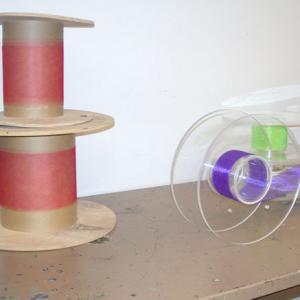College of Liberal Arts & Sciences
1K10.30 - Walk The Spool
Position the spool on the table so it has a few feet to roll. If you pull on the ribbon when it is parallel to the table the spool will roll back toward you. If you pull on the ribbon at an angle almost perpendicular to the table the spool will roll away from you. You can then find the angle between these two cases where the spool can be made to slide on the table without rolling.
- Rod Cross, "Friction Forces on a Pulled Spool", TPT, Vol. 62, #9, Dec. 2024, p. 725.
- Bjarne Schmidt, "Experimental Evidence for the Direction of Friction on a Pulled Spool", TPT, Vol. 62, #5, May 2024, p. 346.
- Rod Cross, "Comments on "Pulling a Spool"", TPT, Vol. 61, #6, Sept. 2023, p. 425.
- Carl E. Mungan, "Pulling a Spool", TPT, Vol. 61, #3, March 2023, p. 178.
- Paul Hewitt, "Figuring Physics", TPT, Vol. 59, #1, Jan. 2021, p. 67.
- William Layton, "Yo-Yo Pull Demonstration", TPT, Vol. 51, # 3, March 2013, p. 172.
- Carl E. Mungan, "A Primer on Work-Energy Relationships for Introductory Physics", TPT, Vol. 43, # 1, Jan 2005, p. 10.
- Carl E. Mungan, "Acceleration of a Pulled Spool", TPT, Vol. 39, # 8, Nov 2009, p. 481.
- "Figuring Physics", TPT, Vol. 36, # 6, Sep 1998, p. 374.
- Denardo, Pemberton, Bhatt, "Raising a Circular Body over a Step", TPT, Vol. 35, # 5, May 1997, p. 278.
- J. D. Nightingale, "Which Way Will the Bike Move", TPT, Vol. 31, # 4, April 1993, p. 244.
- Paul Chagnon, "Animated Displays III: Mechanical Puzzles", TPT, Vol. 31, # 1, Jan 1993, p. 32.
- Richard E. Berg, "Traction Force on Accelerated Rolling Bodies", TPT, Dec 1990, p. 600.
- William Boudreau, "Cheap and Simple Yo-Yos", TPT, Feb 1990, p. 92.
- J. Sherfinski, "Coupled Systems with Constrained Accelerations", TPT, Vol. 26, # 7, Oct 1988, p. 454.
- John Sherfinski, "Rotational Dynamics - Two Fundamental Issues", TPT, May 1988.
- Earl Zwicker, "Physics Activities for Groups", TPT, Vol. 19, # 7, Oct 1981, p. 494.
- Parmley, Swigart, Doran, "Lecture Demonstrations for the High School Science Teacher", TPT, Vol 4, # 1, Jan 1966, p. 36.
- Wallace A. Hilton, "A Spool That Obeys Orders", TPT, Vol 2, # 3, March 1964, p. 139.
- "Frictional Forces Which May or May Not Oppose the Motion", Apparatus Notes, July 1965-December 1972, p. 17.
- Robert Ehrlich, "4.3, Pulling a Spool with a Thread", Why Toast Lands Jelly-Side Down, p. 65.
- Jearl Walker, "1.86, Unwinding a Yo-Yo", The Flying Circus of Physics, p. 44.
- "1.15, Moving Spool", p. 42.
- Janice VanCleave, "178. Roller", 204 Sticky, Gloppy, Wacky, and Wonderful Experiments, p. 100.
- "Force Between Surface and Rolling Object"
- Christopher P. Jargodzki, Franklin Potter, "238. Obedient Spool", Mad about Physics, p. 95.
- Christopher P. Jargodzki, Franklin Potter, "237. Friction Helping Motion", Mad about Physics, p. 94.
- H. J. Press, "166. Turning a Spool", Gaint Book of Science Experiments, p. 178.
- "M-618 Rolling Yo-Yo", DICK and RAE Physics Demo Notebook.
- Martin Gardner, "The Spool That Rolls Backward", Smart Science Tricks, p. 57.
- Julius Sumner Miller, Q104 & A104, Millergrams I – Some Enchanting Questions for Enquiring Minds, p. 66 & 114.
Disclaimer: These demonstrations are provided only for illustrative use by persons affiliated with The University of Iowa and only under the direction of a trained instructor or physicist. The University of Iowa is not responsible for demonstrations performed by those using their own equipment or who choose to use this reference material for their own purpose. The demonstrations included here are within the public domain and can be found in materials contained in libraries, bookstores, and through electronic sources. Performing all or any portion of any of these demonstrations, with or without revisions not depicted here entails inherent risks. These risks include, without limitation, bodily injury (and possibly death), including risks to health that may be temporary or permanent and that may exacerbate a pre-existing medical condition; and property loss or damage. Anyone performing any part of these demonstrations, even with revisions, knowingly and voluntarily assumes all risks associated with them.

